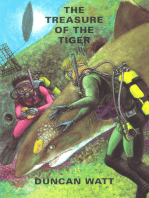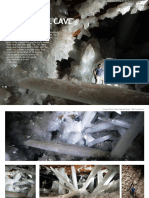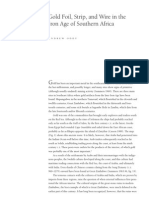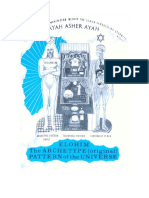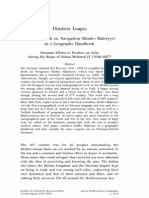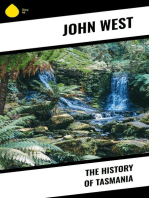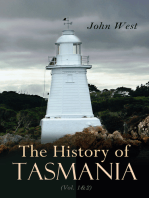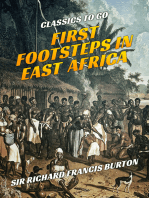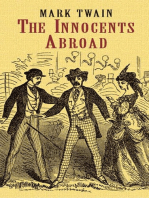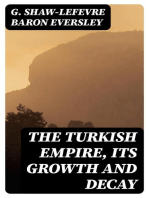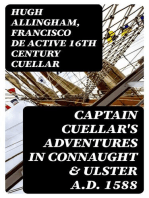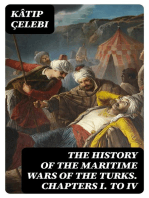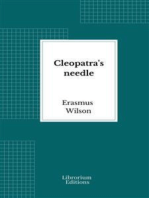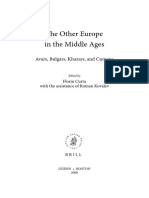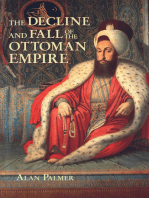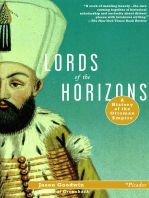Professional Documents
Culture Documents
Map of Piri Reis
Uploaded by
nobilulOriginal Description:
Copyright
Available Formats
Share this document
Did you find this document useful?
Is this content inappropriate?
Report this DocumentCopyright:
Available Formats
Map of Piri Reis
Uploaded by
nobilulCopyright:
Available Formats
2 r
: .
THE OLDEST MAP OF AMERICA DRA WN by PiRI REis
by Prof. Dr.AFETfNAN
.. -~
r: !
r
LLife And Works of the Turkish Admiral: Piri Reis )
i
,
I !
,
'l
l
• :'
THE OLDEST MAP OF AMERICA, DRA WN BY PiRI REfs
hy
Prof. Dr. Afetinan
-r - f'
_-- '/ (j rip: -TO "f'" J._
0- •
Translated by;
Dr. Leman Yolac;
The cover is printed at the "Her ita Umum MildCtrh:i~Ii" Press
TURK TAHiH KURIJMU BASIMEVi-ANKARA
1
9
5
4
---------------------,
A. portion from the map drawn by Toscanelli. (De la Ranciere).
CONTENTS
Life and Works of the Turkish Admiral : Pili Reis.... 3 Discovery of the Map of America... . . . . . . . . . . . . . . .. 3 The Sea-Power of the Ottoman-Turkish Empire in the
XV th and XVI th Centuries................... 5
Biography of Piri Reis (147°-1554)......... . . . . . . . .. 6 -16 Piri Reis' Scholarly Works.......................... 17
The Book "Bahriyc-On Navigation" , 17-23
Piri's First Map of the World, 1513 24-41
Piri's Second Map of the World, 1528............... 42-48 Comparison of Piri Reis' Maps with Other Contemporary
Ones 49-57
Conclusion 58-59
Different Versions of the "Bahriye" , 61-61
Bibliyography , 62-64
The book contains a map of Toscanelli's, printed on cream-laid paper.
A facsimile in colour taken from Piri Reis' 1513 map, printed by the press of Ministry of Education in Istanbul is also added.
(1470-1.5.54)
On the occasion of the fourth centennial of the death of the great admirai and scholar: Piri Reis
LIFE AND WORKS OF THE TURKISH ADMIRAL PIRI REIS
INTRODUCTION
Let us take a trip into some periods of the past. The first stop on this trip will be Turkey thirty years ago. The first quarter of the present century shows Turkey at the end of the War of Independence, and the Republic established by Kemal Ataturk (1923). The Turkish Republic, now thirty Iyears old, was founded on the remains of another Turkish state, the Ottoman Empire (1299-1923).
For the second stop let us take the year 1929. Let us go into the Palace of Topkapi of the Ottoman Sultans, situated
on one of the most beautiful spots of Istanbul called Sarayburnu. The palace, which consists of various buildings, each surrounded by vast gardens, testifies to the different characteristics of the Ottoman period. The Turkish Republican Government decided to turn this palace into a museum.
Discovery of the map of America
In the process of classifying the numerous articles in the buildings, Mr. Halil Edhem, Director of the National Museums, discovered a map* (9 Nov. 1929) till then unknown in the world
• Map, or chart, "portulano" in contemporary phraseology, a term used for all such charts showing the position of ports and based on the idea of the earth being flat.
_. - ---------------------
4 _
of science. Upon hearing of this discovery of the oldest map of America Atattirk showed great interest in the matter. He asked for the map to be brought to Ankara, studied it and ordered it to be published as it stood and to be submitted to scholarly research.
To study this map for the first time with Ataturk was an immense thrill. It had been drawn hundreds of years ago on a roe-skin, with various coloured illustrations and writings on it. As I held it in my hands, I felt as if I were living in the long forgotten past. My emotions are twenty-four years old now, but let us, with the same national and scholarly pride, take a glimpse into the period when this map was drawn and into the history of the man who had drawn it.
This is one of the oldest and yet most perfect maps of America, drawn by a Turkish admiral. Now, if you do not mind being centuries old for a few minutes, come with me to the XVI th century. In this third stop our journey suddenly covers a vast ground.
A view of the Topkapi Palace from the sea. (Taken from an old engraving)
t
\
-------------------------------------- 5
The Sea-Power of the Ottoman-TUI'kish EmpIre m the XV th and XVI tJi' eentUl'Jes
In the XVth century, particularly after the conquest of Istanbul, the Ottoman state grew into an Empire. To secure Turkish domination over the Black Sea and the Mediterranean she had to possess naval strength, which she did. To get the upper hand on the Mediterranean, the Turkish forces had to fight against the Venetians, the Genoese, their usual ally the Knights of St. John, and the Spanish. They finally succeeded in acquiring territorial sovereignty as far as
Fig. 2 -- The Sultan receiving the Supreme Admiral of All-Seas, at the pier of the Topkapr Palace.
6 _
Vienna in west, to the Caucasus, Iran and Iraq in the east, and south and the as a result of adding Syria, Egypt, Tunis, Algiers, the Hejaz and Arabia to the former conquests, formed close contacts on various seas. The Black Sea and the Mediterranean, including the Adriatic shores, came under the domain of the Turkish banner. The fleet carried it across to the Red Sea, the Persian Gulf and the Amman Seas up to the Indian Ocean. The great Turkish admiral, Piri Reis, whose life will be our topic of discussion now, was one of those great Turkish admirals like Burak Reis, Kernal Reis, Muslahiddin Reis, Barbaros Hayrettin, Turgut'and Kihc Ali, who, at the end of the XVth and during the XVI th centuries, won splendid victories for the Turkish fleet, and thus established Turkish power and preserved it over the seas.
Biography of Piri Reis (1470-1554)
We do not exactly know the date of his birth, but we presume it to be between 1465-1470. He was born at Gelibclu or Gallipoli as the Anglo-American world calls it, a lovely coastal town on the Marmara Sea, which was then used as a naval base. He was named Muhiddin Pir i. His father was Had Mehmet, and his uncle, the famous admiral of the period, Kemal Reis. About the children born and brought up in this town, Ibni Kemal, the Turkish historian says: "The children of Gelibolu grow up in water like alligators. Their cradles are the boats. They are rocked to sleep with the lullaby of the sea and of the ships day and night."
This Turkish boy, too, falling asleep with the sound of the sea in his ears spends eleven years of his life in his native town. Like other Turkish children of the time, he acquires -his early notions about the world from the ideas at home and around him, and also from the elementary teaching he was
___________________________________________________ 7
given. After he is twelve, he joins the crew of his uncle, Kemal Reis. Thereafter he is no longer an unknown Turkish youth, but Piri, a careful observer, and a sea-hero whose name will be remembered in history. He starts his career under the vigilance of his uncle, and takes part in all kinds of naval!activities for fourteen uninterrupted years. We can follow him at this period of his life through his book, "Bahriye - On Navi-gtion" in which he recorded his experiences of the places he visited with his uncle, and the historical events of the time in a most vivid and delightful style. The first fourteen years of Kemal Reis'life is spent in piracy, as was the custom at the time. After becoming a considerable power on the sea through his own personal efforts, in 1494 Kemal Reis accepted official recognition and position from the Ottoman Government, along with his worthy and experienced crew.
Several sources confirm the indication - that Piri was with Kemal Reis before this date. For instance, during a period when his uncle was at Egriboz, he says in a passage in the "Bahriye", about the monasteries of Athos, "The aforesaid place is a long cape, 80 miles in length; to the Tracian side lies a dried up channel" (pp. 117-119). In his book, the "Bahriye", he makes the following remarks about the ports on the coast of Athos on the Khalkidhiki peninsula: "In front of the monastery of Alaviri stand native rocks, among which there lies a natural port. It can take only one boat at a time, but since "the mouth of the port lies open to the north, the North and the East winds do much harm to the boat lying there. Itlso happened
,.to us once. As we were lying in harbour the strong East- wind blew across to the north and damaged our boat, whereupon
! the monks from the monastery came to our rescue. They tied the boat down on all the four sides after which she could not move at all. Thus we were saved from the storm, and proceeded on our way." I (Bahriye, p. 113).
8 _
The remarks refer to the coast of Athos .. For the. third peninsula he gives this information: "There is a cape at. Karaburun. People call it the cape of Kesendere. From this cape to "Kumburnu" it is all covered with pine woods. Kumburnu
Fig. 3 -_. The costume of a Turkish sailor on a galleon
Fig. 4- - "Levend" a marine.
--------------------------------------------------- ~
"
is a low and sandy cape; at the point it grows quite shallow. On it, 100 miles to the North-West lies the city of Salonica." In another version of the book he says something different about the same cape: "The coast ofKesendere as far as Kum Burnu is very shallow. Along the coast run tall pine trees. But nobody knows where one can obtain drinking water. To the humble author of these lines Kara Hasan Reis showed the spot."
In 1494 the Moslem population in Granada in Spain asked for help from the Tunisian, Egyptian and the Ottoman Governments. It was just then that Kemal Reis was leading a life of piracy and used his ships to transport these Moslems over to Africa. From 1487 to 1493 Pir i participated in various activities on these seas under the supervision of his uncle.
Piri Reis gives remarkable information about the western coast of the Mediterranean and the islands there, and says the following about the island of Minorca of the Balearic Isles; "They call that port Portulano. It has a good harbour. As soon as you leave the harbour and turn along the eastern coast to the north you come upon a natural spring. It emerges from under a fig-tree. Around that spring you are sure to meet Arab and Turkish boats most of the time, for they obtain their water there. Further over it stands a fortress." [Bahriye p. 532).
During six years of piracy around various islands and coasts on the Mediterranean, they fought against other pirates of the time, conquered ships and in bad weather spent the winter in favourable harbours. Kemal Reis stayed a long time along the African coast, in Algiers, Tunis and Bona, and formed friendly relations with the people there having an exceptionally good reception there. (Bahriye, 1935 Introduction). P. IV Thus while spending the winter months of 1490-149I in the harbour at Bona they took part in the battle led by Kernal Reis against Sicily, Sardinia and Corsica.
, ,.
101 _
One of these battles is recorded by Piri in this way: "There are some shallow spots along the aforesaid bay of Resereno; Terranova is a fortress on a low ground. "Terranova" means "new town" in Sicily. Now, the fore part of the town is a beach, a good shelter in the summer. The vessels lie three to four miles away from the land across the fortress. In the aforesaid harbour we overcame three vessels this time." (Bahriye, p. 493),
Fig. 5 -- Map of Sardinia, in the Bahriye,
Thus each event is recorded with the correct dates. For the island of Corsica Pir i wrote a new chapter (pp. 523-529) and added a map of the island with detailed explanations giving the contour of the island as 400 miles, and said: "On this island stands a tall mountain rising from the north to the south. At this date I counted 25 peaks of this mountain in the eastern part of it. They looked just like the teeth of a saw. Every one of those peaks is covered with snow all through the year" (p. 524).
Fig. 6 --_ Map of Corsica. in the Bahriye.
..
,
, I
.1..
i
I
I
II
t
12 _
About the inhabitants he says: "The aforesaid island of Corsica was a demesne of the Genoese, but later when the French conquered Genoa, among the others, this island, too, passed over to the French."
At the time, the ruling sultan was Bayezid II, son of Mehmet II, the Conquerer. After the death of his brother, Prince Jem, in 1495 Bayezid started ruling the country without a rival. Aiming at greater conquests he endeavoured to reinforce the territorial as well as the naval powers, and for that purpose brought under his banner the various units of Turkish pirate ships. He invited Kemal Reis to join the imperial fleet. He did so, with Piri Reis and Kara Hasan to help him. They all were experienced and trained sailors with good knowledge of the seas. In such a capacity did Piri Reis take part in the Mediterranean campaigns under Kemal Reis' supervision,
The first official acknowledgment of Piri's deeds is an account of the sea fights in the years 1499-1502. The actual commander-in-chief of the fleet belonging to the Supreme Admiral of all the Sea-Forces was Kemal Reis. In this fleet Piri was given official command of some of the vessels. His service in the battles (1500- -- 1 502) against the Venetians was remarkable. The great advantages that the Ottoman Empire acquired by the Treaty of Venice in 1502 were made possible mainly by the brave deeds of these seamen. After this date Piri works as an admiral of the fleet again, but at his uncles's death during a sea battle, Pir i was deprived of his great protector. Because of some reason unknown to us, Piri had not taken part in that battle. There ean be no doubt as to how deep a source of sorrow this loss was to Pir]. The knowledge acquired in the tutorship of Kemal Reis and the accumulated experience during his life at sea had secured him fame and a firm position. After his uncle's death he left the openscas and started working on his first map of the world at Gelibolu. The portion of the map we now possess is a part of it.
_________________________________________________ 13
Along with this map he arranged his notes for the book "Bahriye" which later turned out to be a kind of guide book on navigation. In 1516--1517 Piri was given command of several vessels taking part in the Ottoman campaign against
I I
Fig. 7 ---- The uniform of an Admiral of the fleet.
Fig. 8 _- The costume of a commander of a ship or ships: a "Reis".
L-
--_ ,
14 _
Egypt. Under the command of Cafer Bey the fleet took Alexandria. With a part of this fleet Piri sailed to Cairo through the Nile, and later drew a map and gave detailed information about this area, too.
After Egypt was joined to the growing Empire, Piri had a chance of making the personal acquaintance of the ruling sovereign, Yavuz Selim, during the battle of Alexandria. He presented the map he had previously drawn to the Sultan. After the Egyptian campaign, during a period of relaxation at Gelibolu, he put his notes on "Bahriye" into book form.
The reign of Suleyman the Magnificent, who ascended the throne in 1520, is a history of successive victories. Pir i's taking part in the Turkish fleet going to the campaign on
Rhodes in 1523 is to be regarded as only natural.
Piri commemorates the royal command of Sultan Suleyman to him to act as a guide to Pargah Ibrahim Pasa, the Chief Vizir, in verse (pp. 549-550).
Fig. 9 _ A sea-battle or the Turkish fleet in the XVI. th century.
-
..
___________________________________________________ 15
It was after this campaign that Ibrahim Pasa realized the importance of the "Bahriye" and urged Pir! to put the notes into book form and copy them out again. Piri records that incident, too, at the end of the book in verse. Because of a storm at sea they cannot proceed on their way, and are compelled to take refuge at Rhodes. For Piri, however, this proves to be a good opportunity to make the Pasa's acquaintance. Pirf's frequent references does not fail to attract the Vizir's attention.
Encouraged by his words Pir i rearranges the boka to Gelibolu and copies it all out, and with the help of Ibrahim Pasa presents it to the Sultan. The date of the book is given in verse in the traditional way. From the final couplet one makes the date to be 1526 A.D. (923 by the Arabic Calendar).
In his preface to the book, Pir i mentions the favourable reception it received from the Sultan. Later he draws another map and presents that, too, to Suleyman.
One can follow his life up to 1526 in this book. After this date, we deduce from the state records that Pir-i was appointed an admiral of ships in the south seas. He rendered many services to the government in this capacity, in the Indian Ocean, the Red Sea and the Arabian. Sea. Thus we find him growing old at the head of his ships. He died exactly 400 years ago in 1554, as an old man of 84. Mortal though he himself was, he left behind him immortal works and unforgettable services to the world of civilization.
With this ends the biography of Pir i Reis. Most of it has been taken from his own memoirs on his experiences at seafaring. On the science of navigation, Piri was one of the most outstanding scholars of his time. Apparently, besides his native tongue, he knew Greek, Italian, Spanish and even Portuguese. He acknowledges his debt to various works in these languages, in drawing his map of the world.
~ I
.. %
::~ :;;(li::{'Y h~~)E~ l'h:'~ 'rurk.~ .. s.h·C:H,.t<)H~.a·r:. ~'~'::r~<)d, 'J'hL fla..g"i~ ha-·,.'(· ~s :~·.t::":$~~(~.~::l <)( :l ~:"wc<r;l OF ,(~d ~"l>d. hk~" AU lb>,:(~ Sb.i;:li; W<:~"l' hdlt ir. 'l'Hrki$l: ~·~(K·.k~ a.rsd {':(:k)r}g~~d ~.\:.: a 'prsvii~~l...rHt o~:ga"f;.~~.atj.')J.:. '~r.l~:·(y.;~(:- ·~:f'<.jng ;;.1 (f.;i~ fkNh;d m g', th-r"u,,+. ,; ;:11'$('''' ,·nl.:.\'~Y.' nf l'n!\::'lil"~~,
•
Pm Reis' Scholarly Works
If Piri were' only a helpmate to Kemal Reis, even with the grand titles and high posts that he had won, he would not be a subject important enough for the history of civilization today. We would cite him only as one of the great admirals of the Ottoman Empire when she was a great power on various seas. For, at the time, not only were the Black Sea and the Marmara exclusively Turkish seas, but the eastern and the southern coasts r of the Mediterranean and all the neighbouring islands as well as the eastern coast of the Adriatic were under Turkish domination. The Turkish banner reigned on the Red Sea and the Arabian; the Turkish fleet carried it to the coasts and islands of the Indian Ocean.
To be the ruler of so many seas the Ottoman Empire was bound to have great seamen. And yet Pir i Reis, life and works differ from those of all his contemporaries. He was not content to secure for his country more powers and victories bu(left written works on the science of navigation, which have survived to this day.
_________________________________________________ 17
The Book "Bahriyye-on Naviganon"
Piri Reis then young but quite experienced, travelled on Kemal Reis' ships almost the full length of the Mediterranean coasts, [and on many occasions he was able to study various Spanish, Tunisian, French and Adriatic harbours. Acquiring information on various geographic and naval conditions of these legions, he recorded his own observations on them, and all this formed the basis f01 his book "Bahriye-On Navigation". In it Pir i described the towns and countries along the Mediterranean coasts, and drew maps, charts and pictures of them. He did not neglect giving important information on navigation there, either. Reading the book page by page will take us on a delightful trip along these regions in the XVIth cen-
___________________________________________________ 19
tury. It is, basically, a kind of naval guide book. He gathered all previous information on the subject, but added to it other practical knowledge necessary for sailors on the most important coastal routes, and drew large maps of all the spots he considered important there. In this way the book came out not only as a mere guide book, but also it became the greatest contemporary "portulano" with the most advanced teenique of cartography.
One can see in this book a most significant invention: to make available all that he could not squeeze into the maps, for his readers he drew large maps and complemented them with indexes.
The book has many versions. 29 of them exist in the libraries of Europe and Istanbul. Some of them bear the date 1520 (Arabic 927) the others 1525 (Arabic 932).
The book was published in 1935, with an introduction, an index and a facsimile, based on the version now in the St. Sophia Museum in Istanbul. It has 858 large pages and a section all in verse form, consisting of 78 pages; the latter is divided into 23 chapters, 1107 couplets in all. Into these lines Piri has put all that he learned and observed as well as information indirectly acquired, on the seas of the world, in a style easy to remember and memorize.
The main theme in the book is the Mediterranean coast and the islands there. In Chapters I and II (pp. 7-19). he explains his aim in writing the book and also his life at sea with Kernal Reis In Chapters III, IV, and V (pp. 19-23).he gives information about storms, winds and the compass Chapters VI and VII (pp, 23-29) are about maps and emblematic signs on maps. In Chapter VIII (p. 29) he says that one fourth of the seas that cover the earth has continents on them, and by giving names to each he cites 7 seas. Chapter IX (pp, 30-32) is devoted to the geographic discoveries of the Portuguese. In
,
L~~_
20 _
Chapter X (pp. 33-37) he discusses Abyssinia as extending as far as the Cape of Good Hope and wishes that the Turks may drive back the Dutch and the t Portuguese from the Red Sea. In Chapter XI (pp. 37-43) on the globular chart which he calls "the ball of the earth" he talks about the poles, the tropics, and the equator, and relates what the Portuguese know about them. Chapter XII (pp. 43-52) recounts how the Portuguese make voyages from their own country to the Indies with favourable winds, in a most profitable way. Chapter XIII (pp. 52-56) is general information on navigation, but it also relates some sailors' stories based on fantastic rumours. It includes an account of the Chinese seas, and considering that part of the world as:the end of the East, he gives information on the Chinese people, their customs and traditions and their skill in pottery. The explanations in Chapters XIV and XV (pp. 56-61) about the Indian Ocean and the monsoons are valid even today. He also discusses the wind situations in the Mediterranean and the Aegean Seas. He describes, here, the implement called the "Indian Measure" which measures heights, and also gives information about the Pole Star.
In Chapter XVI (pp. 61-66) he describes the Persian Gulf from what he has heard about it, because then he has not yet been able to visit that'part of the world. He gives a very good account of pearl-fishing and the spots for it. This piece of information is as good as modern since pearl-fishing is still performed in the same way and at the same spots. In Chapters XVII, XVIII, XIX and XX (pp. 67-77) he calls the Indian Ocean "the Sea of the Negroes", and gives an account of the coast and the islands there.
In Chapter XXI (pp. 77-84) he studies the Atlantic Ocean under two different names: "the Western Sea" and "The Great Ocean". He says that the "Western Sea" begins from the Straits of Gibraltar and extends 4000 miles towards the west. He also informs the reader of the continent he cans
"the Antilia". He says, t.bat there the mountains contain rich gold ores, and four fathoms deep in the sea pearl is to be found (p. 78). He discusses the history of the continent and says that it was discovered by sailors. About the inhabitants there he says that they have flat faces, and eyes a full span apart from each other; they are large in build and frightful creatures. He recounts all this on hearsay. He adds to it, though, some personal experiences as to how he once got a hat belonging to the natives on some Mediterranean island. The hat was made of parrots' feathers. There was also an axe made of some hard, black stone that could cut even iron. In this way Pir! wrote most of the information in the margin of the map of America intothis book.
In the chapter on this "Western Sea" we read all that is known about the discovery of America at the time. Of this he recounts, on hearsay again. how a certain book from the time of Alexander the Great was translated in Europe, and after reading it how Christopher Columbus went and discovered the Antilles with the vessels he obtained from the Spanish government.
It is quite evident today that Pir i Reis came into possession of the map that the great discoverer had used.
He makes a reference to the Caspian Sea and says that it is a closed sea. He gives no information, however, about the Red Sea or the Black Sea.
Thus in these 74 pages of verse he was able to gather all the contemporary information about navigation.
The main body of the book consists of 743 pages (pp. 85-848), and these arc divided into 209 chapters with 215 maps and charts. This part is written in prose, the aim being to make it available and easy for every sailor. It begins with the Dardanelles, then goes on to the Aegean Sea, the coastline and the islands there, then the Adriatic Sea and the co-
_____________________________________________________ 21
2~ __
asts along Western Italy, Southern France and Eastern Spain; geographic alnd historical information about the islands there are given and then along the Straits of Gibraltar to the African coast as far as Egypt, then to the shores of Palestine and Syria, to Cyprus and then the Anatolian coastline up to Marmaris. At the end of this part he studies Crete and other islands which he had not previously mentioned. Later coming back to the Straits of Dardanelles he finishes the book with a description of the Gulf of Saros.
Map of Crete in the "Bahriye".
In composing the work Piri first gives historical and geographical information andthen he discusses the necessary practical knowledge on navigation. Each chapter contains detailed char ts, some in different colours. Since his method is still used in modern guide books on navigation and seas one cannot help wondering at the advanced outlook, which the book presents. On many points the accuracy of his statements are indisputable. The work, therefore, must he regarded as very important for the science of navigation.
-- 23
The great sailor-writer draws maps of and gives information about the Adriatic coast in general and about the Bay of Venice in particular. About the latter he says, "The city of Venice etends to an area of 12 miles. The whole district consists of parts of land and parts of an "ear" of the sea. The sea is at some places quite shallow and at others deep. The people have put piles upon these shallow spots and upon them built their city. Before the city was thus constructed fishermen used to come to these lonely spots, spread their nets and catch fisch. When fishing flourished th-ere, more people began to come and then to settle there by building houses over those plies. In the course of time thely increased in number. The wise ones among them thought that they must see to it that the city they were building must be able to stand for all time". (Bahriye, p. 422-423).
Then Piri describes the bulding of the famous St. Marco, the purpose and the process involved in building it. He later tells us that the inhabitants live by trade, and that one has to hire a guide from the fortress of "Yaransa" to go to the city, otherwise, they do not take the responsibility for any loss or damages incurred because of the shallow waters.
The final judgment arrived at about the book, after profound study, is as follows: "Research work done on it reveals that not a single statement can be found in it that is not based on facts". This becomes very obvious in the case of Crete when knowledge concerning the island at two different periods in history is compared. Unfortunately, however, since this great work was not published in the XVI th century and was there fore unknown to the world of science, it has not been as useful as it could have been. Nevertheless the work still retains its importance and value despite the intervening centuries.
..
,
i
24 _
Piri's First Map of the World, 1513
Let us now concentrate on the first map of the world drawn by Piri. His own ideas about carthography in general are recorded in verse form (p. 24). He says that drawing maps requires profound knowledge and specification. He believes that the slightest error in drawing ·a map makes [the map useless (p. 25). To see how faithful he was to this principle of accuracy and exactitude one need only study his maps.
Foreseeing the development of maritime possibilities of the Ottoman Empire in the early decades of the XVIth century. Piri realized the necessity for a map of the world to help those sea-men that would take voyages on the seas, with practical information. In drawing this map, as a sailor devoted to his profession, he applied all the resources then available.
In his preface to the "Bahriye" he refers to the map and says that he has made use of all the known maps, including those on the Chinese seas and the Indian Ocean, which were unknown in the western world at that time. He also records that he presented it to Sultan Selim II. From a note in the margin hand-written by the author himself, we conlude that the map was drawn by Piri at Gelibolu between March and April of 1513 (Arabic gIg). In one of these notes Pir i cites his references and some twenty maps he had made use of. Eight of these were new maps of Mappa Mundi, four drawn by the Portuguese, an Indian one in Arabic, and one by
One of the illustrations of a ship, drawn in colour on the southern part of Africa in the map. (The ship here is drawn to the same
scale as the one on the map.)
f
i I f
f
-
-, i
_________________________ 2S
Christopher Columbus on the western hemisphere. The most important point to be noted here is the fact that Pirt had a map of Columbus, in his hand when' drawing his own. He himself refers to it in the "Bahriye" (p. 82) when talking about Columbus'discovery of the Antilles. This can be accounted for in the following way: he came into possession of the map when he was with Kemal Reis on the Spanish shores on the Mediterranean. In a reference to the shores of Valencia he
o o .11 00
~o8o
~ 0
Pin Reis' first map of the world. The shaded part is the portion we
[' now have, the rest shows the missing parts of it. The dotted region
!, in the north is of the North American area from the
second map of the world.
says that once on those shores he and Kemal Reis took, at a single engagement at sea, seven Spanish vessels (Bahriye, p. 596). We have already noted how he refers to the "Antilia" and the natives of the Antilles.
In one of the marginal notes on the map Piri mentions a Spaniard who had taken part in three of Columbus ~
______________________________________ L
·k. e
26 __ --------------------------------------------
v.,il au.un . ;
.• ·ye~.' 8
fer"ando Rolla
Afo(l!'n~io" ..
T" .. lao (1.
The portion of Piri Peis' map. The place-names are recorded as they are transcribed from the map.
---- 27
expeditions and was later taken prisoner by Kemal Reis. This Spaniard had given a most interesting account of Columbus to Kemal Reis. It is quite possible that he was captured during the battle when some of those articles belonging to the natives were also taken.
The map of Columbus in Piri's possession was drawn in 14g8, and, since we know that Kemal Reis and Piri had fought against the Spanish in 1501, Piri's acquisition of the map during that war is quite plausible.
Although Piri had drawn a map of the whole world, the portion we now have of it is only of the western coasts of Europe and Africa, the Atlantic Ocean, Central and North Americas.
The map is drawn on a roe-skin in various colours. Like other contemporary maps it has no lines of longitude or latitude. Nevertheless we can see two rose-compasses one in the north and the other in the south. Each of the roses is divided into 32 parts and the divison lines are extended beyond the rose frames. Each wind-rose is equal to one sea mile, as is shown in the measurements on the areas near the wind-roses. The map is go/65 centimetres in size.
I t is in various colours and is decorated with numerous illustrations. In the capitals of Portugal, Marrakesh and Guinea, there are pictures of their respective sovereigns. Besides these, on Africa there are pictures of an elephant and of an ostrich, and on South America of lamas and pumas. On
the oceans and along the coasts ~---'
we see illustrations of ships. On both the lands and the seas there are entries sometimes relevant, sometimes irrelevent of
28i _
the pictures. They are all written m Turkish, and can also be found in his book "Bahriye".
You can follow the entry-notes beginning from the north-west corner, turning southward, then proceeding along the perimeter, and finally continuing in a winding fashion towards the center.
Reading some of the notes is really difficult. The map is transcribed by experts as follows :
I - There is a kind of red, dye called vakami, that you do not observe] at first, because it is at a distance. " the mountains contain rich ores .. " There some of the ~heep have silken wool.
II. - This country is inhabited. The entire population goes naked.
III. - This region is known as the vilayet of Antilia. It is on the side where the sun sets. They say that there are four kinds of parrots, white, red, green and black. The people eat the flesh of parrots and their headdress is made entirely of parrots' feathers. There is a stone here. It resembles black touchstone. The people use it intead of the ax. That it is very hard ... (illegible).JPe saw that stone.
Note: Piri Reis writes in the "Bahriye": 'In the enemy ships which we captured in the Mediterranean, we found a headdress made of these parrot feathers, and also a stone resembling touchstone."
IV. - This map was drawn by Piri Ibn Haji Mehrned, known as the nephew of Kemal Reis, in Gallipoli, in the month of muharrem of the year 9 I 9 (that is, between the 9th of March and the 7th of April of the year 15 I 3) .
V. ,- This section tells how these shores and also these islands were found.
These coasts are named the shores of Antilia. They were discovered in the year 896 of the Arab calendar. But it is re-
---------------------------------------------- 29
ported thus, that a Genoese infidel., his name was Colombo, he it was who discovered these places. For instance, a book fell into the hands of the said Colombo, and he found it said in this book that at the end of the Western Sea (Atlantic) that is, on its western side, there were coasts and islands and all kinds of metals and also precious stones. The above-mentioned, having studied this book thoroughly, explained these matters one by one to the great of Genoa and said: "Come, give me two ships, let me go and find these places." They said: "0 unprofitable man, can an end or a limit be found to the Western Sea? Its vapour is full of darkness". The abovementioned Colombo saw that no help was forthcoming from the Genoese, he sped forth, went to the Bey of Spain (king), and told his talc in detail. They too answered like the Genoese. In brief Colombo petitioned these people for a long time, finally the Bey of Spain gave him two ships, saw that they were well equipped, and said :
"0 Colombo, if it happens as you say, let us make you kapudan (admiral) to that country. Having said which he sent the said Colombo to the Western Sea. The late Gazi Kemal had a Spanish slave. The above-mentioned slave said to Kemal Reis, he had been there times to that land with Colombo. He said: "First we reached the Strait of Gibraltar, then from there straight south and west between the two ... (illegible). Having advanced straight four thousand miles, we saw an island facing us, but gradually the waves of the sea became foamless, that is, the sea was becalmed and the North Star -the seamen on their compasses still say star- little by little was veiled and became invisible, and he also said that the stars in that region are not arranged as here. They are seen in a different arrangement. They anchored at the island which they had seen earlier across the way, the population of the island came, shot arrows at them and did not allow them to land and ask for information. The males and the
30 _
females shot hand arrows. The tips of these arrows were made of fishbones, and the whole population went naked and also very .. , (illegible). Seeing that they could not land on that that island; they crossed to the other side of the island, they saw a boat. On seeing them; the boat fled and they (the people in the boat) dashed out on land. They (the Spaniards) took the boat. They saw that inside of it there was human flesh. It happened that these people were of that nation which went from island to island hunting men and eating them. They said Colombo saw yet another island, they neared it, they saw that on that island there were great snakes. They avoided landing on this island and remained there seventeen days. The people of this island saw that no harm came to them from this boat, they caught fish and brought it to them in their small ship's boat (filika). These (Spaniards) were pleased and gave them glass beads. It appears that he (Colombus) had read » in the book that in that region glass beads were valued. Seeing the beads, they brought still more fish. These (Spaniards) always gave them glass beads. One day they saw gold around the arm of a woman, they took the gold and gave her beads. They said to them, to bring more gold, we will give you more beads, (they said). They went and broght them much gold. It appears that in their mountains there were gold mines. One day, also, they saw pearls in the hands of one person. They saw that when; they gave beads, many more pearls were brought to them. Pearls were found on the shore of this island, in a spot one or two fathoms deep. And also loading their ship with many logwood trees and taking two natives along, they carried them within that year to the Bey of Spain. But the said Colombo. not knowing the language of these people, they traded by sings, and after this trip the Bey of Spain sent priests and barley, taught the natives how to sow and reap and converted them to his own religion. They had no religion of any sort. They walked naked and lay there like animals, Now these regions
----____._ .
---------------------------- 31
have been opened to all and have beco-me famous. The names. which mark the places on the said islands and coasts were given by Colombo, that these places may be known by them. And also Colombo was a great astronomer. The coasts and island on this map are taken from Colombo's map.
VI - This section shows in what way this map was drawn. In this century there is no map like this map in anyone's possession. The - hand of this poor man has drawn it and now it is constructed. From about twenty charts and Mappae Mundi -these are charts drawn in the days of Alexander, Lord of the Two Horns, which show the inhabited quarter of the world; the Arabs name these charts Jaferiyefrom eight Jaferiyes of that kind and one Arabic map of Hind, and from the maps just drawn by four Portuguese which show the countries of Hind, Sind and China geometrically drawn, and also from a map drawny by Colombo in the western region I have extracted it. By reducing all these maps to one scale this final form was arrived at. So that the present map is as correct and reliable for the Seven Seas as the map of these our countries is considered correct and reliable by seamen.
VII. -- It is related by the Portuguese infidel that in this spot night and day are at their shortest of two hours, at their longest of twenty two hours. But the day is very warm and in the night there is much dew.
VIII. - On the may to the vilayet of Hind a Portuguese ship encountered a contrary wind (blowing) from the shore. The wind from the shore ... (illegible) it (the ship) After being . driven by a storn in a southern direction they saw a shore opposite them they advanced towards it (illegible) They saw that these places are good anchorages. They threw anchor and went to the shore in boats. They saw people walking, all
of them naked. But they shot arrows, their tips made of fishbone. They stayed there eight days. They traded with these
I ~
l2-- _
people by signs. That barge saw these lands and wrote about them which ... The said barge without going to Hind, returned to Portugal, where, upon arrival it gave information .. , They They described these shores in detail. .. They have discovered them.
IX. - - And in this country it seems that there are whitehaired monsters in this shape, and also six-horned oxen. The The Portuguese infidels have written it in their maps ...
X. - This country is a waste. Everything is in ruin and it is said that large snakes are found here. For this reason the Portuguese infidels did not land on these shores and these are also said to be very hot.
XI. -- And these four ships are Portuguese ships. Their shape is written down. They travelled from the western land to the point of Abyssinia (Habesh) in order to reach India. They said towards Shuluk. YThe distance across this gulf is 4200 miles.
on this shore a tower is however
in this climate gold taking a rope
is said they measured
(Not: The fact that half of each of these lines is rmssmg 18 the clearest proof of the map's having been torn in two.) XIII. - And a Genoese kiike coming from Flanders was caught in a storm. Impelled by the storm it came upon these islands, and in this manner these islands became known.
XIV. -- It is said that in ancient times a priest by the name of Sanvolrandan (Santo Brandan) travelled on the Seven Seas, so they say. The above-mentioned landed on this fish. They thought it dry land and lit a fire upon this fish. when the fish's back began to burn it plunged into the sea,
XII.-
they reernbarked in their boats and fled to the ship. This event is not mentioned by the Portuguese infidels. In is taken from the ancient Mappae Mundi.
XV. - To these small islands they have given the name of Undizi Vergine, That is to say the Eleven Virgins.
XVI. - And this island they call the Island of Antilia.
There are many monsters and parrots and much logwood. It is not inhabited.
XVII. - This barge was driven upon these shores by a storm and remained where it fell ... Its name vas Nicola di Giuvan. On his map it is written that these rivers which can be seen have for the most part gold (in their beds). when the water had gone they collected much gold (dust) from the sand. On their map ...
XVIII. - This is the barge from Portugal which encountered a storm and came to this land. The details arc written on the edge of this map.
(Note: See VIII.)
XIX. - The Portuguese infidels do not go west of here.
All that side belongs entirely to Spain. They have made an agreement that (a line) two thousand miles to the western side of the Strait of Gibraltar should be taken as a boundary. The Portuguese do not cross to that side but the Hind side and the southern side belong to the Portuguese.
XX. - And this caravel having encountered a storm was driven upon this island. Its name was Nicola Giuvan. And on this island there are many oxen with one horn. For this reason they call this island Isle de Vacca, which menas, Ox Island.
XXI. -- The admiral of this caravel is named Messir Anton the Genoese, but he grew up in Portugal. One day the above-mentioned caravel encountered a storm, it was driven upon this island. He found much ginger here land has written about these islands.
-- ~3
3,~ __
XXII.-- This sea is called the Western Sea, but the Frank sailors call it the Mare d'Espagna. Which means the Sea of Spain. Up to now it was known by these names, but Colombo, who opened up this sea and made these islands known, and also the Portuguese, infidels who have opened up the region of Hind have agreed together to give this sea a new name. They have given it the name of avo Sano (Oceano) that is to say, sound egg. Before this it was thought that the sea had no end or limit, that at its other end was darkness. Now they have seen that this seais girded by a coast, because it is like a lake, they have called it avo Sano.
XXIII.-- In this spot there are oxen with one horn, and also monsters in this shape.
XXIV. -- These monsters are seven spans long. Between their eyes there is a distance of one span. But they are harmless souls. I
'* *' it-
The mountains arc drawn in outlines and the rivers are
marked with thick lines. In the map Pit-i Reis adopts and applies the rules of emblematic signs mentioned on page 28 in the "Bahriye". Thus he indicates the rocky regions with black, the sandy and shallow waters with reddish dots, and the rocky parts in the sea which cannot be seen by sailors with crosses.
A close study of the map shows us how faithful Pir! was to his sources. In the bibliography attached to the map he claims that his map is as sound and accurate fer the seven seas as the map of the Mediterranean. From the various Turkish names on these coasts like Babadagi, Akburun, Yesilburun, Kizilburun, Alnn Irrnagi, Gi.izcl Korfez, Kozluk Burnu, tki Hurmahk Burnu etc., we deduce that in his drawing he made use not only of the Portuguese maps in his possession, but also of the information supplied by various Turkish sailors faring
along these coasts. In his drawing of the coastline and in his marking of the sites of importance on it we again notice his remarkable accuracy. He is quite accurate also in the positions of the Azores, Madeira and the Canary islands.
As for the northern part of the map, we see here how Pir i Reis benefited by the new Portuguese maps and recorded On it the discoveries made before 1508 on the North American Coast by Amerigo Vespucci, Pinzon Juan de Solis .Some of the place names on the South American coast, like Santa Agostini, San MegaJi, San Francisco, Port Rali, Total Sr.nte, Abroklok, Cav Frio and Katcnio show a close resemblance to their modern forms. Except for the two entries about the name and the date of the map, all the other entries are written by a calligrapher. This fact can account for the changes to be observed in various names on the map. Another reason for this may easily be the inadequacy of the Arabic script then in use, for expressing Turkish words.
All the principal rivers in South America are marked on the map, though the names are not written. It is remarkable that he should have shown the river La Plate on the map, when Pinzo and Juan de Solis passed by it and from all accounts, never even noticed it. Outside the parts relating to Columbus, 'map the, scales in miles are astonishingly accurate.
'The land extends unipemeded to the west from the south of the Plate. Evidently this part of the map is drawn in accordance with the Ptolemic idea of the world, as is also observed in Mappa Mundi. Eight years later, when he had finished his "Bahriye", in the preface to the book he affirms that, further south it is not land but sea, which shows that he was following ,the later discoveries with careful attention. And yet, from the point of view of the historical importance of these geog'raphic discoveries, this map is particularly significant for Cent.ral America.
------------ 35
3,~ __
Piri Rei,' map showing the eastern regions of America, and the western pans of Africa, Portugal and Spain. Another copy of the map in colour, is to be found in this book. The notes that are left blank
I on this chart can be observed there. The measurements of the original map are 90X6~ centimeters.
___________________________________________________ 37
Close studies here confirm the idea that the map possesses all the important information that was on the map of C. Columbus drawn and sent to Europe in 1498 and also on the map of Toscanelli that Columbus had in hand when he first ventured out on his voyages. This part of the map contains many imaginary islands with a picture of a parrot on each. The island of Trinidad is written as "Kalerot", which probably is derived from a cape on this island which Columbus called "Galera". Porto Rico is named here San Juan Batichdo, and on its eastern coast is drawn the. picture of a fortress. There is, however, another island to the west of Trinidad, again with a picture of a parrot near which is written San Juan Batichdo. Drawing various islands on the South American coast opposite Trinidad shows the influence of Colombus, who believed this newly discovered continent to be a group of islands. This is to be. observed also on the island of Haiti, called by Columbus Hispanyola, and by Piri the Island of Spain: instead of showing it extending from the east to the west, as it does, he shows it extending from the north to the south, which proves that Columbus took this island to be Zipang, i.e. Japan as Marco Polo calls it ·and in accordance with Marco Polo's descriptions of it, the island is given this mistaken position.
The real Antilles are shown on the map not as islands, but as C. Columbus believed it to be, as a continent. Hence Piri calls Central America "the County of Antilia", and the North American coast "the coast of Antilia". It is true that
at a certain spot quite near the North American coast there is marked an island called the Antilia, but evidently that stood for the legendary island popularly regarded as fabulously wealthy and prosperous at the time when Columbus first started on his voyages. It is to be noted, however, that beside the island is a note that states that, contrary to the common fallacy. the island is not prosperous. Cuba, too, is shown as a continent accordance with Columbus' firm belief. So confident was
38 __
'\I.
,\
\,., ........ :\
j v
;
)
.'
~':
k~ \i
...
o ,. ~ • •
.. ~'y/
to,
o
A comparison of Piri Reis' map with the modern conception of this area. As it will be easily perceived the distance between South America and Africa is quite correct. r.omparison with the other contemporary maps reveals Piri's greatness in the technique of cartography.
-------------------------------------------------- 39
Columbus in this that while he was near the coast of Cuba in J 494 he had his conviction recorded by the notary public on the boat, Fernand Perez de Luna, and asked all the crew to sign it, as we can now see from the document signed on the i zth June, 1494, which declares that. since it is quite evident that this is a continent, thereafter whoever attempts to contradict this statement shall be fined to 10.00 Maravedis pieces and also his tongue shall be cut out. Undoubtedly the reason why Piri, too, shows it as a continent was not because he was afraid for his tongue, but because he would not question the veracity of a piece of information given by such an authority as Columbus, who had been to those parts of the world several times. Cuba is shown as a continent also in the map of Columbus dated
The map attributed to "Toseanelli" and~later re-drawn by Kretchner.
Over the land in the north-west is written: "ManCl Katay India", and over the island in the center: "Cipanda".
1498, which formed the basis for Piri's later one, in the rough sketch drawn by Christopher Columbus' brother, Bartholomeo, in 1503, in the map of the world made by Ruysch in 1508, and even in the marine map by Waldeesmuller in 1507.
Pirl calls the eleven islands on the south-east of Haiti "Undizi Vergine," which shows that the number of the islands is not expressed by the word "onze" which means eleven in Spanish but by its equivalent in Columbus' mother tongue, Italian. This is another indication of how faithful Pir i was to Columbus' map, Keeping close te the information of Columbus' map which apparently possessed all that was on the earlier Toscanelli map, Piri handed down to us the oldest map of America and informed us about various aspects of the most important phase in the history of the discoveries. By recording the explanations given by the Spaniard who had taken part in the three expeditions of Columbus and was later captured by Kemal Reis, he related the story of these discoveries from an original source free from the later legendary tales which have grown about them.
The map of the world drawn by Waldseemuller. bearing the date 1507.
I
;
Scattered about the map are some other entries which also enlighten us about various details in the discoveries. Beside the picture of a ship near the Azores is written that this Genoese vessel came from Flanders, was shipwrecked, and that the survivors discovered these islands. From another entry we learn that the sea there is the Western Sea, but the Europeans call it the Spanish Sea, and after the discoveries of Columbus' the name is changed to Ovasana, i.e. "Osean",
By a picture ncar the island of Santiano is a note stating that the names of these places were found and given by a Genoese sailor brought up in Portugal. In anosher entry close to the picture of a ship drawn near the South American coast he summarizes all the information given in a map by Nikola di Juan who was shipwrecked there. In one of the notes on the Atlantic Ocean he mentions the treaty of "Tordesillas" 1599, and a certain line that divides the Spanish and the Portuguese possessions.
Towards the north, on the map is a picture of a fish on which is drawn a woman and a man making a fire, nearby is another ship and three people in a boat. This is the story of Santa Brandon which was very popular in the middle ages, and was recorded in the "thousand and one night" stories. But Piri does not neglect to add that the legend comes down not 'from the Portuguese but from the old Mappa Mundi. This. shows that the Turkish' geographer made use of many sources and did not neglect the latest information nearest to his age, and that he was very careful about his bibliography.
From various kinds of research work done on the map we conclude that compared with the other maps of the period, Piri's is the most perfect and original. It will interest the Americans as one of the oldest maps of their country, and we Turks will always be proud that the author of the maps was one of us.
----------------------- __ 4'
42 _
The Second Map of America
Fifteen years after this first map, Piri Rcis drew a second one, again at Gelibolu. Like the previous one it bears his signature. Unfortunately to-day we have only a small portion -of it i.e. a small portion of the western hemisphere. It is 68/69 centimeters in size. Ornamental figures are drawn in the margins and most of it is in colour.
_.\ part of the second map of the world drawn by Piri Reis, showing North America, and dated 1528 (Arabic 935)·
_____________________________________________________ 43
There we find the northern part of the Atlantic Ocean and the newly discovered regions of North and Central America. There are four wind-roses on it. The tropic of Cancer is shown here, though it was not on the first map. Then' are also scales of milles on it, each with twenty divisions. From the notes beside them we gather that the distance between the divisions stand for 50 miles, and that between two dots for 10 miles. The scales here are bigger than in the previous one. We see Greenland in the north and the Azores towards the south. Some of the latter bear the names "San Mikal", "Santa Mariya", "Euriko", and "San Jorjo". To the south of Greenland two large pieces of land are shown; the one in the north is called Baccalao, On the map there is a note saying that Baccalao was discovered by the Portuguese. In another note further down near "Terra Nova" he says that though these coasts were discovered by the Portuguese ,all is not known as yet, and only the parts that have been discovered arc shown on the map. Further south still one can ~ee the Peninsula of Florida drawn very much as we know it today. He calls it San Juan Batista. The name was first given to Porto Rico on the previous map.
The pieces of land seen at the side arc the peninsulas of Honduras and Yucatan, discovered in 1517 and 1519 respectively. Unlike the first map, drawn under the influence of Columbus, the islands of Cuba, Haiti, the Bahamas and the Antilles are drawn quite accurately. One can read the words "lsi di Varia" over Cuba. Although there arc numerous names along the coast of Venezuela, very few can be read. Among the legible words are San Cilormi, Monte Krago, Detonos, Die Sagram, Ponte Sogon, Didas and Sare.
44 __
In this second map the drawing of the coastlines shows greater improvement in technique and also close resemblance to the modern conception of these areas. The stony and rocky sections are given special care. There is, howerer, a slight distortion in the map from the true position of the continent as we know it today .
. ~"." ..
--------- - --
: .
:. "; LalliOldad
A portion from Piri Reis' Map showing North America.
___________________________________________________ 45
This error was committed, due to neglect in not taking into consideration the ten to thirteen degrees of difference in angle on the contemporary compass. This error is to be observed in all the contemporary maps without any exception.
On this map, as on the previous one, there are some explanatory notes, but they are recorded more briefly. The note on the left-hand corner of the map, under the scales with the long and ornamental points, gives the signature of the author as well as the date 1528 (A. H.· 935). Beside the measurements there is a note indicating the milage, where he says that the distance between two sections is 50 miles and between two dots. 10 miles.
Over the second set of scales further north he says again that the distance between two sections is 50 miles and between two dots 10. The idea in the two statements is the same but one or two words differ.
Beside place-names in the notes near Labrador he says: ·'This is Baccalao, The Portuguese infidels discovered it. All that is known about it is recorded here". From the position on the map we understand that these coasts are of "Terra Nowa". Today we know that the Portuguese explorer, Carl Real, discovered Terra Nova in 1500, and his brother, Miguel Real, a year later in 1501, discovered Labrador.
Though part of the note over Central America is damaged what remains is quite interesting. "Dividing the land ... to find where the sea begins... the vilayet that ... beyond which", can be read.
Here there is a reference to an explorer who planned to cross overland to reach the ocean. It is quite possible that Piri meant by that Balboa who crossed Central America and reached the Pacific Ocean in 1513.
Another interesting term used on the map is what he calls the tropics: "Day's Lengthening". In his own words
46 _
the explanation runs as follows: c'Bu hat gun gayet uzadlgl yere isarettir" which means that these lines indicate the part of the world where the. days grow longer.
- -
-
- -
-
Sailors in the rfith Century, in crossing the Atlantic Ocean from the coasts of Europe and Africa used to take advantage of the trade wi ,ds and the gulf streams. In this map the latter are shown with pointed
arrows indicating the direction taken.
The line drawn over Cuba should, of course have been drawn further north, and the peninsula of Yucatan should have been put entirely below it; but that much accuracy could not be expected of the cartographical techniqne of the period.
__j
_______________________________________________ 47
Such technical errors can be observed also in other contemporary maps. We should, therefore, acknowledge the greatness and value of the work among other maps of the period after pointing out briefly to its various merits and demerits.
A galleon
As it can be easily observed from this map, Piri Reis continued following the new discoveries with great interest. It is remarkable that, by taking into account the results of the new discoveries, he should correct in this map the
48 _
inaccuracies of the first in which he was misled through his unquestioning confidence in Columbus' map. In this second map Pirl Reis showed only the parts of the world that had been already discovered and left the unexplored areas blank, explai ning this by the fact that they were as yet unknown. Thus, Piri proved, once again, how he observed the prin-
ciples of scientific methods in drawing this map. .
The mosque called .. Agalar Camisi" at the Palace of Topkapi where these historical maps are kept.
-------------------- 49
Comparison of Piri Reis' Maps with Other Contemporary Ones
The maps or charts called portulanos, i. c. handbooks on navigation, were first drawn in the thirteenth century. We do have examples of such works previous to that period, but the kind that could bear comparison with Piri Reis' ale mainly in the fourteenth to sixteenth centuries.
The first portulano in Europe IS found in the work of Adamus Brernensis in 1076. Then comes the map called pisane, presumably drawn in the thirteenth century. The maps which appear after that bear the name of the author and the date of the drawing. The earliest among these is the portulano of Pietro Vesconti, dated 1320. To this is added a section of Marino Snudus' work, under the name of "Libcr Secretarum Fidelium Crucis".
Thus, considering the development of this type of handbook and charts, it will be useful to make a short comparative review of other such contemporary works, especially of maps showing America,
The portulanos and the handbooks written after the fourteenth century mention the island of "Brasil", and in [4[4 the island of +Cipangu" and the "Antil ia" arc shown. It is believed that between 1474 and 1482 Toscanelli sent a portulano together with a letter to Christopher Columbus.
Unfortunately, these documents have not survived. In that letter he is supposed to have said that according to the testimony of several who had gone that way, if one kept on going to the west he was bound to reach Asia eventually.
According to what De la Ronciere wrote, this Portuguese map was drawn between 1488 and 1493. A photograph of the map will be found on another page in this book, together with the portion that Kretchner re-drew (p. 39).
50 __
The information spread all over the world after I507 when Amerigo Vespucci wrote in a letter that it was a new continent and he called it "Nevus Mundus". St. Die, who published the letter, suggested the name "America" for it.
The date of this portulano known as the "La Cosa Map" is 1500. La Cosa was the most noted cartographer and sea-man of this period. He participated in the first voyage of Columbus and served as official cartographer on the second. The map we now have is based upon his own observations. The most important points to be noted here arc the line of the equator and the Meridians which are drawn in conformity with the Tordesillas agreement (1494). There arc illustrations on some parts of Europe and Africa, but not on America. Only in the north the British and in the south the Castillian flags are to be observed. The distances between the continents on the maps, especially when compared with Pir i Reis' prove to be
very inaccurate.
--
________________________________________ 51
On the other hand there are some who claim that the name of America was adopted because the natives of Nicaragua called a part of their land "America". It is true that in the first half of the XVI th century this new continent di ew the attention of geographers, and that resulted in various maps being drawn cf it. Pirl Reis was one of these cartographers. Hence, a comparison of his works with some other contemporary maps drawn between 1507- I550 will reveal to us the gr eatnes of Pirl maps as historical documents in the discovery of America.
The map of the world known as Gloreanus', drawn in 1510. (At Bonn Library). Though the book that contains a re-print of the map ascertains the date to be I.') 10, the matter can bear further scholarship for confirmation.
52 ___
I
.lean Severs' map, showing a part of Europe and Africa with another part of South America. I t is believed to be published in 1514 at Leyd. When compared with Piri's:even a casual glimpse shows the great errors in the drawing of America and especially in the distance between the two continents. There is hardly any line dividing Central and North Americas, nor does it have the usual explanatory notes of a portulano on it. The coastline of Europe and Western Africa, however, are drawn with greater accuracy. The wind-roses are shown here with arrows to the north.
_____________________________________________________ 53
Map of the world. attributed to Lopa Hamen, dated 1519. The roundness of the earth is indicated here by the circular frame. Although at many points on Asia and Africa he is quite incorrect his greatest error lies par ticularly in the coastline of the north-east regions of America. South Arne-rica looks quite similar to that of the map on the preceding page. A closer study will reveal to us the inaccuracy in the distance between the two continents.
Furthermore, there is shown a continent joining Asia and America in the
North Pole. Though Pir i had made the same mistake in his first map in 1513, he corrected it in the later book dated 152!. This is a con tempo rary map of the world. but little does it tell us of America.
A portion from another portulano of the XVt th Century, showing North America. Basically it resembles the other map; of the period, The distance between thc two continents is (00 short.
___________________________________________________________________ 55
Map of an unknown Portuguese, dated 1520. I t also bears close resemblances to the other maps. The distance between the two continents is again incorrect. The map has, however, entry notes on:it as does Piri's. The onc over Brazil runs as follows: "The vegetation and fowls in this land are quite different from those in our own country."
In a statement attributed to Isidore, the Spanish scholar from Seville (d. 6361 there is an interesting remark: "There lies another continent besides sied th .. three known ones, beyond the ocean, far up north, and there the sun is warmer than anywhere in our country." (Etymologies, Bk. 14, Chapter 5)
These words of Isidore are noteworthy for the information given eight hundred years before Columbus.
56, __
This map, too, is a XVI th Century portulano. (I have been unable to ascertain the date of composition.) Great errors are noticeable in the drawing of the continents, especially of Africa. To the south of it there is a picture of an elephant. Explanatory notes are given almost all over it. There is a large island in the north of the map, that is called "America". To the north and south of it are drawn nets. In the middle of it is a picture of a bird. There are three rivers in the south. Despite all the illustrations given here, there is nothing remarkable here from the point of
scholarship except for the word" America".
This map is included here so as to permit comparison with other contemporary works.
1\'.-
_____________________________________________________ 57
A map of America, dated 1550, and published in Sebastian MUnster's cosmography. Although it still lacks the true proportions America has now assumed the form of a continent. Over the land in the north-east can bc read "Francisca ", next to it by the ranges of-mountains in North America "Terra Florida", and in the south "Nevus Orbis", Another interesting point in it is the way Japan is shown to be in America, and its rrame recor ded there as "Zipangu". In the south-west over the land is written "India" Although this was drawn many years after Pir i Reis' two maps, it has many mistakes in it. The most noteworthy point there is the way a different continent is shown between the two oceans, and to the north of it the word "Americarn",
58 __
Conclusion
As it has already been stated, at the time of Piri Reis, the Ottoman- Tur kish Empire was the dominant power over the Black Sea, the Marmara and the Red Sea, and was fighting for prevalence over the Aegean, the Mediterranean and the Indian Ocean. For such a position the Empire had to have a fleet equipped with all the latest weapons. The State Archives give us some most interesting and rich material concerning these organizations. What the author of this booklet wanted to show, however, was only some of the characteristic features of a Turkish sailor and scholar, the writer of a marine guide-book and the cartographer of two maps of the world, a man who had taken part in numerous private and state enterprises on various seas.
Close studies of the maps reveal to us the fact that when compared with other contemporary maps these prove to be composed with a most advanced scientific spirit and method. The two maps of Pir i complete each other. We are indebted to such valuable guides in the world of scholarship for enlightening us in this most important phase of the geographic discoveries. In any history of the period they must be taken as data of direct information. The bibliography will show the wealth of publication on these works. The author has always taken intense pleasure in studying this subject on various occasions, and thought it to be her duty to share some of the information with an increasingly larger group of readers.
Piri Reis' life and works show not only the great heroic and warlike qualities of the Turks in the XV th and XVI th centuries, but also their contribution to the world of scholarship and civilization. Piri lived in an age when the Turkish culture was fertile in every field. The XVI th century
__ -------------------------------------- 59
is universally regarded as the Golden Age of the Turkish civilization in history. Piri was one of those who left great works behind them not only for their own nation but for all the science of world geography, and thus became an important figure for the history of civilization. A nation lives as long as she can produce cultural works through each epoch.
To conclude: the two maps of Piri Reis will not fail to interest the Americans as the oldest maps of their own land. And we Turks will always be proud to have had the author of such works, and will be glad to remember that our ancestors were also interested in the American continent.
r
Different Versions of The "Bahriye"
Bahriye bears two different dates: ly20 (Arabic 927); 1525 (Arabic 932) The first version of it received popularity among the contemporary seamen and was copied out to be used in the fleet.
The other version is the one that was presented to Suleyman after the author made new additions to it. Neither of the original copies have been found as yet. The existing copies in the libraries are later versions of these.
1521 Version
1 - 1stanbul. The Library of the Treasury Department, Top-
kapr Palace. No: 575
2- 1stanbul. Topkapi Palace Library. No: 333 3- 1stanbul. Nuruosmaniye Library. No: 2290.
4- Istanbul. Nuruosmaniye Library. No: 2292 Date: 1628 5- istanbul. Koprulu Library. No: 172. (No date)
6,7- istanbul. Library of the Naval Museum. No : 59, 50 (2 copies).
3- Dresden. Date of copy: 1544 (Arabic: 961). Part of it was published in 1926 by Paul Kahle.
9-90 Bologne. No: 3612-3613. Only one has a date: 9574- (A. 982)
11- Berlin. Prof. Martman. 1644 (A. 1050) 12- Berlin. State Library.
,
I
__ ------------------------------ 61
13-14- Paris. National Library. No: 220-965 (956). One bears the datc: 1587 (A. 996)
15- Vienna. No datc.
16- London. Oxford Bodleian Library.
1525 (Arabic 932) Version
17- istanbul. Library of St. Sophia. (This version was published in 1935 in Istanbul with an introduction, an index and a facsimile.) ,
IH- istanbul. University Library. No: 4654
19- istanbul. Koprulu Library. No: 171
20- istanbul. Topkapi Palace, Revan Library. No: 18-1633 21- istanbul. Husrev Pasa Library. No: 264. r770 (A. 1184) 21- istanbul. Husrcv Pasa Library. No : 1770 (A. 1184) 22,23- Istanbul. Library of the Naval Museum. No:) 88.
(No date)
24- istanbul. Millet Library. No: 1
25- istanbul. Topkapi Palace, Bagdad Kiosk Library. No : 388 26,27- istanbul. Nuruosrnaniyc Library. No. 2989 - 3004.
2B- istanbul. Asir Efendi Library. No: '227
29- istanbul. Yeni Carni Library. No : 790
BlBLIOGRAPHY
ABOULHAK AONAN --- La Science chez les Turcs Ottomans. Paris, 1939, pp. 59-64.
A. AONAN Anrv AR <-Osmanli Tiirklerinde llim. istanbul, 1943. pp. 55-68.
AFET-Bir Turk Amirali, XVI. asrtn biiyiik ceografi: Pirt Reis, S. 3 I 7-332. Un Amiral, Geographe Turc du XVI.e siicle-Piri Reis, auteur de la plus ancienne Carte de I' Amerique. pp. 333- 348. Belleten, Vol. I, 2 Ankara I, April, 1937.
AFETiNAN-America's oldest map, made by an Turkish admiral: Piri Reis, Translated by: Miss Leman Yolac. Ankara, 1950. (From a talk given at the National Library in Ankara.)
AKQURA, YUsuF-1Uap drawn by Piri Reis. Turkish interest in America in 1513: Piri Reis' Chart of the Atlantic Made some ten years after Columbus' first discoveries and seven years before Magellan rounded Cape Horn! pp. 142- 143 "Illustrated London News", 23, July 1932.
AKQURA, YUSUF- Piri Reis haritasz hakkinda izahname - Die K arte des Pin' Reis. Piri Reis map. Carte de Pin' Reis. T. T. K. No. I istanbul, 1935.
ALPAGUT H. vc F. KURTOGLU- Mukaddime, I - LV. Piri Reis:
Kitab-l Bahriye. T. T. K. NO.2, istanbul 1935.
BATAiLLON, LIONEL -- La decouverte de I' Unioers par l'homme visage du monde (Evolution humaine) Paris, 1934.
BAYKAL, BEKIR SITKI - XIX. Asra kadar Akdenizde hdkimiye: devresi. Ankara 1938. C.H.P. publications, Serial No: I, Bk, 29, pp. 29 - 30.
CALLI EN W. Y. Me - The evolution of the map of the Earth. S. 122-148. Dunya haritasmm evrimi [hulasa), pp. 149-153. Ankara 0 niversitesi Dil ve Tarih-Cografya Fakultesi dergisi, Vol. VII. Serial No: Ankara I, March, 1949.
DEISMANN A. - Forschungen und Funde im Serai. Berlin-Leipzig. 1933. pp. 111-122.
..'"'·" ........ .' .......... _It ~
____________________________________________________ 63
EFTALEDDiN-Bir Vesika-i Miieliim, Tarihi Osman! Enciimeni mecmuasi, Vol. 4. [ October (A. H. [326-1328), pp. 201-210.
HALiL ETHEM- Topkapi Sarayi. istanbul 193 I.
HUMPHREYS, A. L. SKELTON, R. A. - Decorative Printed Maps of the 15th to 18 th Centuries. London, 1952. Old decorative Maps and Charts. (by A H. Humphreys).
iBNi KEMAL-"(Kemal Pasazade Sernseddin Ahmed d. 1535)", Teoarih-i Al-i Osman. The ninth of the ten books: "Yavuz Selim devri".
JOMARD - Les monuments de La geographie, Paris, 1864'
KAHLE, PAUL-Piri, Reis Bahriye, Das tiirkisches Segelhandbucb fur das Mittelldndische Meer vom Jahre 1521. Berlin-Leipzig 1926. Band 1. Text, Band II. Ubersetzung.
KAHLE, PAUL-Piri Reis, und seine Bahriye, (Beitragc zur his, torischen Geographic) 1927.
KAHLE, PAuL-Die Verschollene Columbus Korte von 1498 in einer Tiirkischen Weltkarte von 1513. Berlin, Leipzig 1933.
KAHLE, PAuL-Improrte Colombiane in una carta Turca del lSI., "La Cultura" anno, X - Vol. I. Fas. 10. Roma 153 I.
KATip GELEBi - Keifiizzunun Topkap: Kiitiiphanesi No. 233/35362.
"Cihanniima" lstanbul 1659 (1065)
KONY ALI, 1BRAHiM HAKKI- Topkapt Saraytnda deri iirerine yaptlrnl,f eshi haritalar. Istanbul, 1936.
K. KRETEHMER-Die Entwicklung der Kartographie von Amerika, Gotha 1891.
MAHMUT, ~EVKET- Teskildt ue kiyofet-i askeriye. Vol. 1 and II Istanbul, 1325, Umuru Bahriye pp. 33-37.
MAHMOUD, CHEVKET PACHA--L'organisation et les uniformes de FArmee Ottomane (depuis sa creation jusqu, a nos jours) MEHMED, SUREYY A-Sicil-i Osmani; yahut terkere-i mesahiri Osmaniye. Vol. II. lstanbul, 1319, p. 44.
MUHARREM, FEYzi-XVIIl. asirda Turk askeri kzyaJetleri. Turkish Military Uniforms in XVIII th Century. istanbul, 1933- Tho. MC. Lean- 1818, London.
~4 __
f
NORDENSK]OLD A. E.----(Facsimilie) Atlas to the Early History of Cartography With reproduction of the most important maps printed in . the XV. and XVI. centuries, Stokholm.
OBERHAMMER-Eine Tiirkische Karte zur Entdeckkung Amerikas, aus dem Anzeiger der Akademie der Wissenschoften Wien 1931, pp. 99-112.
D'OHSSON-M. DE M. Tableau General de l'Empire Othoman (Vols. I, II, III,) Vol. III. Paris, (1820). PP. 340-436.
PiR! REis-Piri Reis Haritast, (Facsimile from the first map of the world).istanbul 1935, T.T.K. No.!.
PiR] REis-Kitab-z Bahriye. (Facsimile of the St. Sophia Museum, No. 202). Istanbul 1935, T. T. K. Publications No. '2.
PAULiN, CHARLEs-Atlas of the Historical Geography of the United States, Washington, 1932, Edited by J. K. Wright, American Geographical Society of N cw York. . (Although this book was published after the discovery of Piri Reis' map, it has no reference to this work.)
RONCiERE CH. DE LA - La carte de Ch. Colombe. Paris, 1924. RONCiERE CH. DE LA -- L' euoluiion humaine des origines a nos jours, Paris 1934.
SADi, HAMiD - - Tiirklerde Haritactltk ve Cograba, (Turk tarihinin ana hatlan, Seri II. No. 40) T. T. K. istanbul.
SELEN, SADi HAMiD -Piri Reis'in Simali Amerika Haritasi, PP. 515-518. Belletcn Vol. I, '2 April, 1937. Die Nord Amerika-Karte des Piri Reis (15'28).
UZUN9AR§ILI, tSMAiL HAKKI- Osmanlt Deoletinin Merke; ue Bahriye Tqkilatl. Ankara 1948, pp. 389-5'28. T.T.K. VIII. No. 16.
UZUN9AR~ILI-:--ORD. PROF. 1. H. Osmanli Tarihi. Ankara 1949, Vol. I. T.T.K. XII. No. 16/'2. 192-195 pp. 284-286.
YURDAYDIN, HUSEYiN G.-Kitab-t Bahriyenin telif meselesi PP. 14.3-146 June 195'2 D. T. C. Quarterly; Vol. X, 1'2.
Map drawn by Pirt Reis, one of the Turkish Geographers. "Illustrated London News", 25, February 193'2·
* *" '*
You might also like
- Wiltshire Archaeological and Natural History Magazine: 1854 Vol 1 Nos 1 3Document398 pagesWiltshire Archaeological and Natural History Magazine: 1854 Vol 1 Nos 1 3kephalaiaNo ratings yet
- Sistem Suria: - Nama-Nama PlanetDocument15 pagesSistem Suria: - Nama-Nama PlanetNor ShahirahNo ratings yet
- 1 - Progres Pengembangan Sistem Kawasan Konservasi - Bahasa PDFDocument58 pages1 - Progres Pengembangan Sistem Kawasan Konservasi - Bahasa PDFnaryo69No ratings yet
- Tycho BraheDocument26 pagesTycho BraheAntaresdeSuenios100% (1)
- Predynastic Period: Badarian CultureDocument2 pagesPredynastic Period: Badarian CulturejamessonianNo ratings yet
- The Dark Ages - Were They Darker Than We Imagined?Document11 pagesThe Dark Ages - Were They Darker Than We Imagined?SyncOrSwimNo ratings yet
- The Sunken Foreunners of AsiaDocument18 pagesThe Sunken Foreunners of Asianeuweil1No ratings yet
- Ancient Egyptian BoatsDocument50 pagesAncient Egyptian BoatsUroš Matić100% (1)
- Hidden EmpireDocument9 pagesHidden EmpireErikNo ratings yet
- Ancient Worlds - DocuWikiDocument6 pagesAncient Worlds - DocuWikisam nugrohoNo ratings yet
- The Celestial Chariot East and West (J) - Bulletin of The Asia InstituteDocument20 pagesThe Celestial Chariot East and West (J) - Bulletin of The Asia InstituteGabrielzyxNo ratings yet
- The Lost Library of The Mayan ItzaDocument3 pagesThe Lost Library of The Mayan Itzahttp://www.whatis-theplan.org/No ratings yet
- Sinking of Atlantis by Nibiru in 9577 BC: Part 2, Mechanics of SinkingDocument13 pagesSinking of Atlantis by Nibiru in 9577 BC: Part 2, Mechanics of SinkingAnonymous HsoXPyNo ratings yet
- The Crystal Cave PDFDocument4 pagesThe Crystal Cave PDFilhamNo ratings yet
- Seafaring LN The Bronze Age MediterraneanDocument10 pagesSeafaring LN The Bronze Age MediterraneanHermes AegeanNo ratings yet
- Ancient and Historic Metals 3/3Document123 pagesAncient and Historic Metals 3/3argaricoNo ratings yet
- Movement of The Earths Crust Continental Drift TheoryDocument65 pagesMovement of The Earths Crust Continental Drift TheorySophia FrueldaNo ratings yet
- The Growth of Medieval CitiesDocument24 pagesThe Growth of Medieval CitiesJayson100% (6)
- IDMR TextDocument337 pagesIDMR TextAndrew LoboNo ratings yet
- PiriReis TDocument68 pagesPiriReis TManuel CapdevilaNo ratings yet
- Dimitris Loupis Piri Reis' Book On Navigation (Kitab-I Bahriyye) As A Geography HandbookDocument15 pagesDimitris Loupis Piri Reis' Book On Navigation (Kitab-I Bahriyye) As A Geography HandbookNur UrfaliogluNo ratings yet
- Navy of Süleyman The MagnificentDocument70 pagesNavy of Süleyman The MagnificenthalimboharilubisNo ratings yet
- Nelson's Arctic Voyage: The Royal Navy’s first polar expedition 1773From EverandNelson's Arctic Voyage: The Royal Navy’s first polar expedition 1773No ratings yet
- Kemet: The History of Ancient EgyptFrom EverandKemet: The History of Ancient EgyptRating: 3.5 out of 5 stars3.5/5 (4)
- First Footsteps in East Africa; Or, an Exploration of HararFrom EverandFirst Footsteps in East Africa; Or, an Exploration of HararRating: 3.5 out of 5 stars3.5/5 (18)
- The Western Shores of Turkey Discovering The Aegean and Mediterranean Coasts CompressDocument420 pagesThe Western Shores of Turkey Discovering The Aegean and Mediterranean Coasts CompressDenem OrhunNo ratings yet
- Phoenician Shipwrecks of The 8th To The 6 TH Centuries AcDocument8 pagesPhoenician Shipwrecks of The 8th To The 6 TH Centuries AcSérgio ContreirasNo ratings yet
- Phantom Islands: In Search of Mythical LandsFrom EverandPhantom Islands: In Search of Mythical LandsRating: 3 out of 5 stars3/5 (2)
- Captain Cuellar's Adventures in Connaught & Ulster A.D. 1588From EverandCaptain Cuellar's Adventures in Connaught & Ulster A.D. 1588No ratings yet
- Piri ReisDocument7 pagesPiri ReisAnonymous nirGvSNo ratings yet
- Legendary Islands of the Atlantic: A Study in Medieval GeographyFrom EverandLegendary Islands of the Atlantic: A Study in Medieval GeographyNo ratings yet
- Steamships and OttomansDocument8 pagesSteamships and OttomansEmir Yener100% (6)
- The History of the Maritime Wars of the Turks. Chapters I. to IVFrom EverandThe History of the Maritime Wars of the Turks. Chapters I. to IVNo ratings yet
- A Broken Mirror The Kipchak World PDFDocument34 pagesA Broken Mirror The Kipchak World PDFPop GabrielNo ratings yet
- The Story of Extinct Civilizations of the WestFrom EverandThe Story of Extinct Civilizations of the WestNo ratings yet
- Lords of the Horizons: A History of the Ottoman EmpireFrom EverandLords of the Horizons: A History of the Ottoman EmpireRating: 3.5 out of 5 stars3.5/5 (110)
- Eco6896 8621Document4 pagesEco6896 8621Tifa SaceNo ratings yet
- Ahmedis History of The Ottoman DynastyDocument8 pagesAhmedis History of The Ottoman DynastySaid GülNo ratings yet
- Fahmy MuslimSeaPowerDocument105 pagesFahmy MuslimSeaPoweroxyinfoNo ratings yet

